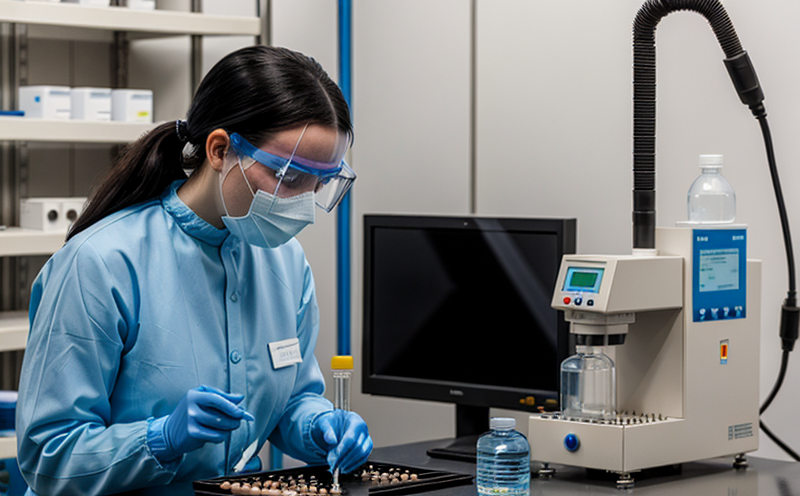Ion Pair Chromatography Impurity Testing
Ion pair chromatography (IPC) is a specialized form of high-performance liquid chromatography used in pharmaceutical testing to separate and quantify impurities within drug substances. This method is particularly effective for analyzing polar compounds, which are often challenging to resolve using other techniques due to their low solubility in non-polar mobile phases.
The principle behind IPC involves the use of an ion pair reagent that forms a stable complex with the analyte (the substance being analyzed). This complexation enhances the solubility and stability of the compound, allowing it to be more easily separated from other components. The mobile phase in IPC typically contains a weakly basic or acidic buffer, which acts as the ion-pairing reagent.
The pharmaceutical industry relies heavily on IPC for impurity profiling because it provides precise and accurate data necessary for ensuring product quality and compliance with regulatory standards such as ICH Q3D. This service is essential in identifying and quantifying trace amounts of impurities that might otherwise go unnoticed, thereby minimizing the risk of contamination or inconsistency in drug formulations.
During sample preparation, a clean room environment is crucial to prevent cross-contamination. Samples are often diluted with appropriate solvents before injection into the chromatographic system. The choice of solvent and dilution ratio can significantly impact the performance of IPC, as it influences both the efficiency of complex formation and peak resolution.
The instrumentation used in IPC typically includes a high-performance liquid chromatograph (HPLC) equipped with a diode array detector (DAD). This setup allows for comprehensive spectral analysis that aids in qualitative identification and quantification. Additionally, mass spectrometry can be integrated to enhance the specificity of impurity detection.
The methodology followed involves several key steps: sample preparation, injection into the HPLC system, separation under optimized conditions, detection, and data processing. Optimization of parameters such as flow rate, column temperature, and mobile phase composition is critical for achieving optimal resolution and sensitivity.
Compliance with international standards ensures that results are reliable and reproducible across different laboratories. Adherence to ICH Q3D guidelines guarantees that the testing meets current regulatory expectations regarding impurity levels in drug products.
Scope and Methodology
The scope of ion pair chromatography impurity testing encompasses a wide range of applications within pharmaceutical development and manufacturing. It includes but is not limited to:
- Detection and quantification of trace impurities in drug substances.
- Identification of process-related impurities that arise during synthesis, purification, or formulation.
- Evaluation of residual solvents and degradation products post-processing.
The methodology involves a series of steps designed to ensure accuracy and precision:
- Sample Preparation: Ensures purity and minimizes potential interferences. This may involve dilution, derivatization, or extraction techniques depending on the nature of the impurities.
- Injection and Separation: Utilizes IPC to separate the analyte from other components based on differences in affinity for the ion-pairing reagent.
- Detection: Employing advanced detectors like DAD or MS for detailed characterization of peaks.
- Data Analysis: Interpretation and reporting of results against predefined acceptance criteria.
This comprehensive approach ensures that all critical impurities are identified, quantified, and reported accurately. Compliance with relevant standards such as ICH Q3D further enhances the reliability and robustness of these tests.
Benefits
- Enhanced Product Quality: Precise detection and quantification of impurities contribute to higher product quality standards.
- Absence of Cross-Contamination Risks: Clean room environments minimize the risk of introducing contaminants into samples.
- Regulatory Compliance: Adherence to ICH Q3D ensures that drug products meet stringent regulatory requirements.
- Improved Process Understanding: Identification and quantification of impurities provide insights into manufacturing processes, helping to optimize procedures for better outcomes.
These benefits underscore the importance of ion pair chromatography in maintaining high standards of pharmaceutical testing.
Use Cases and Application Examples
In practice, ion pair chromatography impurity testing plays a crucial role in various aspects of pharmaceutical development:
- New Drug Substance Development: Early-stage research where potential contaminants are identified before they become problematic.
- Process Optimization: Monitoring changes during synthesis to ensure consistency and quality.
- Quality Control: Routine checks on finished products to maintain batch-to-batch consistency.
For instance, in the development of a new drug substance, IPC can be used to identify any unintended by-products or impurities introduced during synthesis. This early detection allows for corrective measures to be implemented promptly, preventing costly delays later in the pipeline.
In process optimization, IPC helps tailor purification steps to reduce residual solvents and degradation products. By monitoring these parameters regularly, manufacturers can ensure that their processes are as efficient and clean as possible.
For quality control purposes, IPC provides assurance that each batch of a drug product meets specified purity standards. This is critical for maintaining consistency in the market and building trust with regulatory bodies and consumers alike.





